|
Introduction to Design Thinking
What is Design Thinking? 
Introduction to Design Thinking: A Human-Centered Approach to Creative Problem-Solving
Design Thinking is a dynamic and human-centered problem-solving approach that places people at the heart of the design process. It is more than just a methodology; it's a mindset that prioritizes empathy, collaboration, and iteration to tackle complex problems and generate innovative solutions.
At its core is about understanding the needs and experiences of the end-users. It starts by empathising with them, gaining deep insights into their challenges, and developing a profound understanding of the context in which they operate. This empathic understanding serves as the foundation for the entire design process.
Collaboration is another key pillar of Design Thinking. It recognises that diverse perspectives lead to richer solutions. Design Thinking encourages interdisciplinary teams to work together, bringing in varied expertise, skills, and viewpoints. By fostering a collaborative environment, it ensures that the solutions generated are comprehensive and consider multiple angles.
The iterative nature sets it apart from traditional problem-solving approaches. Instead of pursuing a linear path, Design Thinking involves a cycle of prototyping, testing, and refining ideas. This constant refinement is based on feedback received from end-users, allowing for continuous improvement and adaptation.
In essence, Design Thinking is not confined to designers or creative professionals; it is a mindset that can be applied across disciplines. Whether solving business challenges, developing products, or enhancing services, Design Thinking offers a structured yet flexible framework that encourages creative problem-solving and innovation. As we delve deeper into the principles and stages of Design Thinking, the power and versatility of this approach will become increasingly apparent.
Design Thinking traces its roots to the mid-20th century, primarily within the field of design. The term gained prominence in the 1960s and 1970s, with design theorists and practitioners like Herbert A. Simon and Robert McKim exploring ways to enhance creativity and problem-solving. However, it was the collaboration between design firm IDEO and Stanford University in the 1990s that propelled Design Thinking into mainstream consciousness.
Design Thinking expanded beyond its design-centric origins, finding applications in diverse fields. Initially, it was embraced by business and technology sectors seeking innovative solutions. Over time, its influence spread to education, healthcare, government, and beyond. This evolution reflects a growing recognition of the approach's effectiveness in addressing complex challenges across various domains
Design Thinking stands apart from traditional problem-solving methods, particularly analytical approaches, by its distinctive emphasis on user-centricity and experimentation.
User-Centric Nature: While traditional problem-solving often starts with defining the problem from a technical or organizational perspective, Design Thinking places the user at the forefront. It begins with empathizing with the end-users, understanding their needs, desires, and pain points. This human-centered approach ensures that solutions are not just technically sound but also resonate with the people they aim to serve.
Experimental Mindset: Unlike analytical problem-solving, which tends to follow a linear and deductive path, Design Thinking is characterized by an iterative and experimental mindset. Design Thinkers actively embrace uncertainty, encouraging rapid prototyping and testing. This iterative cycle allows for quick adjustments based on user feedback, fostering continuous improvement throughout the design process.
The Stages of Design Thinking:
Design Thinking typically unfolds in a series of interconnected stages, providing a structured framework for problem-solving. While variations exist, a commonly accepted model includes the following stages:
- Empathize: This stage involves understanding the users' needs and gaining insights into their experiences. Design Thinkers engage in activities like interviews, observations, and surveys to develop a profound understanding of the users' perspectives.
- Define: With empathy as a foundation, the next step is to define the core problems and challenges faced by users. This stage involves synthesizing the gathered information to identify the key issues that need addressing.
- Ideate: Ideation is a creative brainstorming phase where Design Thinkers generate a wide array of ideas. The emphasis is on quantity and diversity, encouraging wild and unconventional suggestions. This stage encourages thinking beyond conventional boundaries to explore innovative solutions.
In the subsequent stages—Prototype, Test, and Implement—Design Thinkers continue refining and validating their ideas through tangible prototypes and feedback loops, ultimately arriving at a solution that is not only functional but also deeply resonant with the end-users.
Design Thinking, with its emphasis on empathy, collaboration, and iteration, offers a holistic approach to problem-solving that extends far beyond traditional methods. As we delve into the application of these principles in real-world scenarios, the transformative impact of Design Thinking becomes increasingly evident.
Applications: Design Thinking has demonstrated its versatility and effectiveness across a wide range of industries and sectors.
- Business and Product Innovation: In the business realm, companies like Apple and IBM have employed Design Thinking to drive product innovation. By understanding customer needs and preferences, these companies have created products that not only meet functional requirements but also resonate emotionally with users.
- Education and Learning Design: In education, Design Thinking has transformed curriculum development and learning experiences. Educators use the approach to tailor teaching methods to the needs of students, fostering a more engaging and effective learning environment.
- Healthcare Solutions: In healthcare, Design Thinking has been instrumental in developing patient-centric solutions. From improving the design of medical devices to enhancing the patient experience in healthcare settings, Design Thinking has contributed to positive changes in the industry.
- Government and Social Innovation: Governments and non-profit organizations have embraced Design Thinking to address complex social issues. By involving the communities affected, Design Thinking facilitates the creation of more inclusive and effective solutions in areas such as poverty, urban planning, and public services.
As we delve deeper into the principles and applications of Design Thinking, participants will gain a comprehensive understanding of how this approach can be a transformative force in problem-solving and innovation across diverse contexts.
The Design Thinking Process 
Introduction to the Design Thinking Process:
The Design Thinking process is a systematic and structured approach to problem-solving and innovation, commonly involving multiple interconnected stages. It's a versatile framework that guides individuals and teams through a creative journey, ensuring a holistic and user-centric development of solutions.
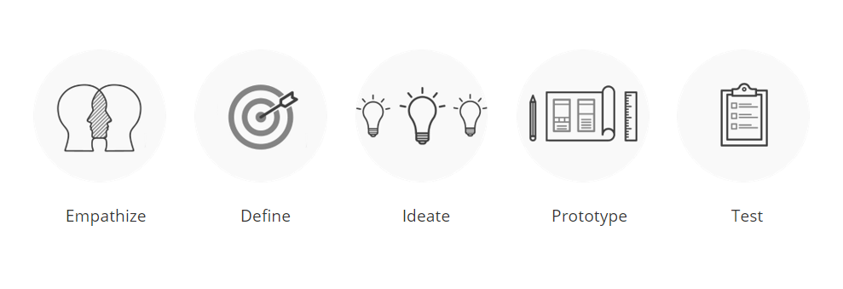
|
Stage 1: Empathize with End-Users:
Understanding the needs, behaviors, and motivations of end-users is the foundational stage of Design Thinking. By immersing themselves in the users' experiences, participants gain valuable insights that serve as a compass throughout the design process. This stage involves conducting user research, interviews, and observations, fostering a deep sense of empathy for the target audience.
|
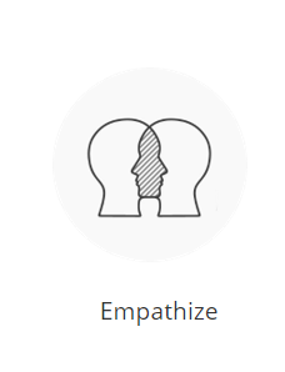 |
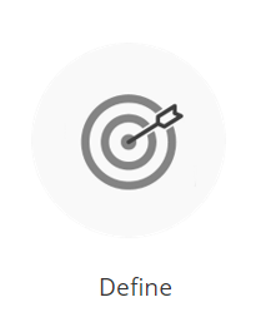 |
Stage 2: Define the Challenge:
In this stage, participants learn the importance of framing the problem or challenge in a user-centric manner. Reframing problems as opportunities, participants utilize techniques like crafting problem statements and developing user personas. By defining the challenge with a clear understanding of the users' perspective, Design Thinkers set the stage for innovative and relevant solutions.
|
|
Stage 3: Ideation:
Ideation is where creativity and brainstorming take center stage. Participants explore various ideation techniques, including brainstorming, mind mapping, and the SCAMPER method. The goal is to generate a multitude of innovative ideas without judgment. This phase encourages thinking beyond traditional boundaries and sets the stage for the next steps in the design process.
|
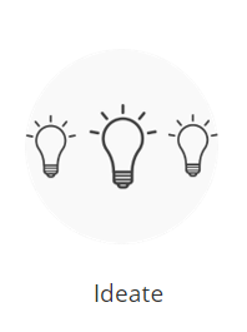 |
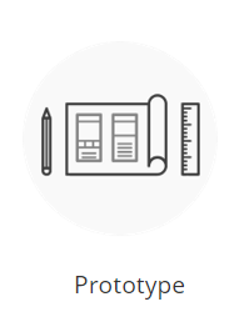 |
Stage 4: Prototyping:
Translating ideas into tangible prototypes is a crucial step in the Design Thinking process. Participants delve into the world of prototyping, exploring different types ranging from low-fidelity sketches to high-fidelity models. Prototypes serve as tangible representations of ideas, facilitating testing and refinement. This hands-on approach encourages Design Thinkers to move beyond theoretical concepts to practical, user-tested solutions.
|
|
Stage 5: Testing and Feedback:
User testing and feedback collection are integral components of the Design Thinking process. Participants learn how to gather insights from end-users and use them to refine and iterate on their prototypes and concepts. This stage emphasizes the importance of real-world validation, ensuring that solutions not only meet the intended needs but also resonate with the users on a practical level.
|
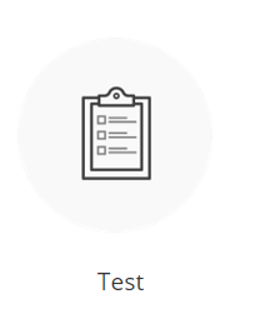 |
Iterative Nature of Design Thinking:
Design Thinking is not a linear process but an iterative one. Participants understand that revisiting and reworking stages is not only acceptable but often necessary. As new insights emerge, the iterative nature of Design Thinking allows for continuous improvement and adaptation. This flexibility ensures that the final solution is a result of a dynamic and responsive design process.
As participants navigate through the stages of the Design Thinking process, they will experience a transformative journey that promotes creativity, empathy, and user-centric innovation.
Defining Challenges and Identifying Opportunities 
Critical initial steps of Design Thinking involve framing problems effectively and identifying opportunities for innovation.
- Effective Problem Framing: The success of any design endeavor hinges on the clarity of the problem being addressed. Design Thinkers understand the importance of crafting problem statements that act as beacons, guiding the creative process. A well-framed problem statement is clear, specific, and tightly aligned with the needs and experiences of end-users. It serves as the foundation upon which innovative solutions are built. By emphasizing effective problem framing, the groundwork is set for a Design Thinking journey that is purposeful and directly addresses the challenges faced by users.
- Empathy and User-Centricity: Empathy is the heartbeat of Design Thinking. To create solutions that truly resonate with end-users, participants delve into the art of understanding their perspectives. User interviews, surveys, and observations become tools for cultivating this empathic connection. By walking in the shoes of the users, Design Thinkers gain profound insights into their challenges, preferences, and aspirations. This empathetic understanding is the catalyst for user-centric solutions that go beyond meeting functional requirements to address the genuine needs of the people being served.
- User Personas: User personas are the embodiment of user-centric thinking. In this stage, participants learn to create fictional representations of typical users, weaving together demographic information, behaviors, and goals. These personas serve as archetypes that encapsulate the diverse needs and preferences of the target audience. By putting a face and a story to the users, Design Thinkers humanize the design process, fostering a deeper connection with the people they seek to serve. User personas become compass points, guiding decisions and ensuring solutions resonate with the intended audience.
- Problem Reframing Techniques: Innovation often starts with asking the right questions. Participants are introduced to problem-reframing techniques that stimulate creative thinking. "How Might We" (HMW) questions encourage participants to explore possibilities, framing challenges as opportunities for innovation. Brainstorming sessions unleash a flood of ideas, and the use of design briefs adds structure to the creative process. By adopting these techniques, Design Thinkers break free from conventional problem-solving, unlocking a realm of possibilities and paving the way for transformative solutions.
- Identifying Opportunities: Design Thinking is not confined to troubleshooting; it's a proactive exploration of opportunities for innovation. Participants learn to see beyond the immediate challenges and recognize unmet needs. By adopting a mindset that actively seeks out opportunities for improvement, Design Thinkers become agents of positive change. This proactive approach ensures that the solutions generated not only address existing problems but also contribute to a future where user experiences are continually enhanced.
- Real-World Examples: Theory comes to life through real-world examples. Participants explore case studies where effective problem framing and user-centric thinking have led to tangible successes. From product design to social innovation, these examples illustrate the transformative power of Design Thinking in action. Real-world scenarios provide inspiration and serve as evidence that the principles explored in this section are not just theoretical constructs but powerful tools for creating meaningful and impactful solutions in a variety of contexts.
Ideation and Prototyping
Ideation Techniques 
This section is focused on fostering creativity and idea generation through various ideation techniques. It encourages participants to think outside the box and generate innovative solutions.
Ideation is the heartbeat of creativity in the Design Thinking process. It is the phase where the floodgates of imagination open, allowing for the generation of a wide range of ideas. Participants will understand the significance of ideation as a crucial step in Design Thinking. This creative process lays the foundation for innovative solutions by encouraging participants to explore, experiment, and think beyond conventional boundaries.
Brainstorming:
Introducing brainstorming as a powerful group activity, participants learn how to unlock the collective creativity of a team. The rules of brainstorming, such as deferring judgment and prioritizing quantity over quality initially, create an environment where ideas flow freely. Participants discover how this structured yet liberating technique fosters a culture of open expression, enabling the emergence of diverse and innovative ideas.
Mind Mapping:
Mind mapping is a visual technique that empowers participants to organize and explore their thoughts in a non-linear format. Participants will understand how mind maps serve as dynamic tools for uncovering relationships between concepts, revealing hidden connections, and stimulating creative thinking. By visually mapping out ideas, Design Thinkers gain a holistic view of potential solutions and their interconnections.
SCAMPER Method:
The SCAMPER method introduces a structured approach to creative problem-solving. Participants will delve into each element of the acronym—Substitute, Combine, Adapt, Modify, Put to another use, Eliminate, and Reverse—and learn how to apply them to generate innovative ideas. This method sparks creativity by encouraging participants to approach challenges from various perspectives, opening the door to unconventional and inventive solutions.
Storyboarding:
Storyboards offer a narrative approach to visualizing ideas and concepts. Participants will explore how this technique helps in understanding user experiences and scenarios by creating a visual storyline. By translating ideas into a narrative format, Design Thinkers can identify potential challenges and opportunities, leading to more empathetic and user-centered solutions.
Collaborative Ideation:
Highlighting the benefits of collaborative ideation, participants learn how bringing together diverse perspectives and expertise enhances creativity. Cross-functional teams are emphasized as a means to enrich ideation sessions, ensuring a broad spectrum of ideas that draw from various disciplines and viewpoints. This collaborative approach enhances the potential for groundbreaking and multidimensional solutions.
Creative Constraints:
The concept of applying creative constraints is explored as a method to stimulate innovative thinking. Participants discover how limitations can act as catalysts for creativity, pushing them to think outside the usual boundaries. Constraints are reframed as opportunities, inspiring Design Thinkers to devise unique and inventive solutions within defined parameters.
Concept Development 
Concept development is a phase in the design process that involves refining and structuring creative ideas into actionable concepts and solutions. This phase follows the ideation stage, where a wide range of ideas is generated. The goal of concept development is to transform these raw creative concepts into more tangible, well-defined, and user-centric solutions.
- Refine Ideas: Concepts are scrutinized, and the most promising and innovative ideas are selected for further development. This involves considering the practicality, feasibility, and alignment with the project goals.
- Structure Solutions: Concepts are organized and structured to address specific problems or challenges. This phase may involve creating detailed outlines, frameworks, or visual representations that showcase how the solution will work in practice.
- Consider User Needs: The development process places a strong emphasis on understanding and addressing the needs of end-users. This involves revisiting user personas, user journeys, and user scenarios to ensure that the developed concepts are user-centric.
- Create Design Briefs: Design briefs are created to provide a clear and concise outline of the problem, the target audience, and the proposed solution. These briefs act as guiding documents throughout the concept development phase, ensuring a unified vision and understanding among the team members.
- Prioritize Concepts: Concepts are evaluated and prioritized based on criteria such as feasibility, desirability, and viability. This step helps in selecting concepts that are not only innovative but also practical and achievable within the given constraints.
- Align with Prototyping: Consideration is given to how the concepts will transition into tangible prototypes during the prototyping phase. This alignment ensures that the envisioned solution is accurately translated into a physical or digital form that can be tested and refined.
- Iterate and Refine: The concept development process is iterative, meaning that concepts may evolve and change based on feedback, testing, and further insights gained from stakeholders and end-users. This flexibility allows for continuous improvement and optimization of the proposed solutions.
- Concept Development Process: Concept development is the phase following ideation where ideas are refined and structured into actionable concepts and solutions. It acts as a critical bridge between the creative generation of ideas and the subsequent prototyping phase.
- User Personas and Needs: User personas and their needs form the foundation for user-centric concept development. By understanding the target audience and their requirements, concepts can be tailored to address real challenges and resonate with the intended users.
- Storyboarding and User Scenarios: Storyboarding and user scenarios contribute to visualizing how concepts will address the needs and challenges of end-users. Storyboards provide a visual representation of the user's journey, offering insights into the practical application of concepts.
- Design Briefs: Design briefs provide a structured outline of the problem, target audience, and proposed solution. Crafting effective design briefs guides the concept development phase, ensuring a clear and concise roadmap for the team.
- Prioritization and Feasibility: Prioritization is based on feasibility, desirability, and viability criteria. Assessing the feasibility of implementing each concept within organizational resources and constraints ensures that concepts selected for further development align with practical realities.
- Prototyping Considerations: Consideration of how concepts will transition into tangible prototypes is crucial. Aligning concepts with the upcoming prototyping phase ensures that the envisioned solution is faithfully translated into a tangible, user-tested form.
- Iterative Refinement: Concept development is inherently iterative. Concepts evolve through feedback and testing, allowing for continuous refinement. Flexibility to iterate based on insights gained from end-users ensures continual optimization for user satisfaction and effectiveness.
- Practical Application: The section concludes with practical exercises and case studies. Creating concept outlines, storyboards, and design briefs for selected ideas allows for hands-on application of concept development principles, preparing for the next stages of the Design Thinking process.
Prototyping and Testing 
- Introduction to Prototyping: Prototyping is the practical realization of concepts, creating tangible representations for visual or functional testing of ideas. It allows designers to move beyond abstract concepts and brings ideas to life in a tangible form. It's essential to note that prototypes can vary in fidelity, from low-fidelity sketches to high-fidelity models, depending on the stage of development and the specific goals of testing.
- Types of Prototypes: Exploring various types of prototypes, participants will encounter paper prototypes, wireframes, mock-ups, and functional prototypes. Each type has its advantages and appropriate use cases. For instance, low-fidelity prototypes like paper sketches are quick and cost-effective for early-stage ideation, while high-fidelity prototypes provide a more realistic representation of the final product.
- Prototyping Tools and Software: Introducing prototyping tools and software like Adobe XD, Sketch, and Figma, participants will learn how digital prototypes can be created efficiently. These tools enhance collaboration, streamline the design process, and facilitate the creation of interactive and dynamic prototypes.
- User Testing and Feedback: Emphasizing the importance of involving end-users in the testing process, participants will understand that user testing is a critical step in validating the design's effectiveness. User testing helps identify usability issues, gather valuable feedback, and ensures that the final product aligns with user expectations and needs.
- Creating Test Scenarios: Participants will learn how to design test scenarios and tasks for user testing. Structuring user testing sessions with well-defined scenarios allows for the collection of specific insights, ensuring that the testing process is focused and provides meaningful feedback.
- Iterative Prototyping: Highlighting the iterative nature of the prototyping process, participants will grasp that prototypes are refined based on user feedback. Iterative prototyping allows for continuous improvements to the design, ensuring that each iteration brings the solution closer to meeting user requirements and expectations.
- Usability Principles: Introducing fundamental usability principles, such as simplicity, consistency, and feedback, participants are reminded of the core elements that contribute to a positive user experience. Considering these principles during prototyping ensures that the final product is not only functional but also user-friendly and intuitive.
- Feedback Collection and Analysis: Participants will learn how to collect user feedback, document observations, and analyze the results of user testing sessions. Techniques for synthesizing and prioritizing feedback are discussed, enabling designers to distill actionable insights that guide further iterations.
- Refinement and Iteration: Stressing the importance of using user feedback for refinement, participants are encouraged to iterate and improve their designs based on testing results. The refinement and iteration process ensures that the final solution is well-adapted to user needs and preferences.
- Practical Prototyping Exercises: Incorporating hands-on exercises, participants engage in creating prototypes and conducting user testing. These exercises may include creating low-fidelity paper prototypes or digital prototypes using prototyping software. Practical application allows participants to apply theoretical knowledge, strengthening their prototyping and testing skills.
Implementation and Feedback
Design for Implementation 
Design for Implementation is the phase that follows ideation and concept development, focusing on turning innovative ideas into actionable plans. It bridges the gap between the creative stages of Design Thinking and the practical steps required to bring solutions to life.
- Alignment with Organizational Goals: Emphasizing alignment, the importance of ensuring that Design Thinking solutions align with the broader goals and objectives of the organization is highlighted. This strategic alignment ensures that initiatives contribute meaningfully to the organization's direction and vision.
- Resource Allocation: Discussing resource allocation, the focus is on effective management of time, budget, and personnel to support the implementation of Design Thinking solutions. Strategies for optimizing and leveraging resources are explored to ensure efficient and successful implementation.
- Project Planning: Introducing project planning, the essentials of defining project scopes, establishing timelines, and identifying critical milestones are emphasized. Creating a comprehensive project plan becomes a key focus, outlining the steps required for the successful implementation of Design Thinking solutions.
- Cross-Functional Collaboration: Emphasizing collaboration, the importance of cross-functional teamwork during the implementation phase is highlighted. Collaboration across various departments and stakeholders is crucial for a holistic approach that ensures Design Thinking solutions are effectively brought to fruition.
- Change Management: Addressing the challenges of organizational change, strategies for managing resistance and ensuring a smooth transition during the implementation of innovative solutions are discussed. Change management becomes a critical aspect of successfully embedding Design Thinking into organizational processes.
- Risk Assessment: Explaining the significance of risk assessment, the focus is on identifying potential challenges or barriers to implementation. Strategies for mitigating risks and planning for contingencies are explored, ensuring a proactive approach to challenges.
- Monitoring and Evaluation: Discussing ongoing monitoring and evaluation, the need for defining key performance indicators (KPIs) and evaluation metrics is emphasized. This ensures continuous measurement of progress and success throughout the implementation of Design Thinking initiatives.
- Communication and Reporting: Highlighting the importance of clear communication, the focus is on maintaining effective communication channels throughout the implementation phase. Creating regular progress reports and communicating updates to stakeholders ensures transparency and stakeholder engagement.
- Documentation and Knowledge Transfer: Stressing documentation, the importance of capturing the implementation process, lessons learned, and best practices is emphasized. Facilitating knowledge transfer within the organization ensures that insights gained during the implementation phase are shared and retained.
- Practical Application: Including case studies and practical exercises, the emphasis is on developing implementation plans for Design Thinking solutions relevant to organizations. Practical application allows for the application of theoretical knowledge, ensuring readiness to navigate the complexities of implementing innovative solutions.
Measuring and Evaluation Design Impact 
- The Importance of Measurement:
Emphasize the critical importance of measuring the impact of Design Thinking initiatives to ensure alignment with organizational objectives and justify investments in the design process.
- Defining Key Performance Indicators (KPIs):
Explain the process of identifying and defining specific KPIs crucial for measuring the success of Design Thinking projects, establishing clear, measurable goals aligned with project objectives.
- Data Collection and Analysis:
Discuss various methods and tools for collecting relevant data to track established KPIs, exploring techniques for data analysis to gain insights into the performance and overall effectiveness of Design Thinking initiatives.
- Qualitative Assessment:
Highlight the value of qualitative assessment methods in understanding the impact of Design Thinking solutions on user experiences, encompassing user feedback, satisfaction surveys, and qualitative data.
- Quantitative Metrics:
Introduce various quantitative metrics for measuring the impact of Design Thinking, including measurements related to revenue generation, cost savings, efficiency improvements, and enhanced customer engagement.
- Benchmarking:
Explain the concept of benchmarking and its role in evaluating the performance of Design Thinking initiatives. This involves comparing projects against industry standards or competitors to assess relative performance.
Summing up 
|
 Design Thinking is a human-centred, creative problem-solving approach that emphasizes empathy, iteration, and holistic problem framing. It has evolved beyond its design origins, finding applications in diverse fields such as business, education, and healthcare. The core principles include a deep focus on understanding and empathizing with users, an iterative process, and a holistic approach to framing problems. Its versatility and effectiveness are evident through successful applications across various industries. Design Thinking is a human-centred, creative problem-solving approach that emphasizes empathy, iteration, and holistic problem framing. It has evolved beyond its design origins, finding applications in diverse fields such as business, education, and healthcare. The core principles include a deep focus on understanding and empathizing with users, an iterative process, and a holistic approach to framing problems. Its versatility and effectiveness are evident through successful applications across various industries.
|
 |
 The course introduces the "Design for Implementation" phase, emphasizing the transition from ideation to actionable plans. Cross-functional collaboration and teamwork are underscored as crucial elements in this phase. Ongoing monitoring, risk assessment, and evaluation are highlighted to ensure the successful execution of Design Thinking solutions. The importance of measurement is stressed, involving KPI definition, qualitative/quantitative assessment methods, and practical application to gauge the impact and success of initiatives. The course introduces the "Design for Implementation" phase, emphasizing the transition from ideation to actionable plans. Cross-functional collaboration and teamwork are underscored as crucial elements in this phase. Ongoing monitoring, risk assessment, and evaluation are highlighted to ensure the successful execution of Design Thinking solutions. The importance of measurement is stressed, involving KPI definition, qualitative/quantitative assessment methods, and practical application to gauge the impact and success of initiatives.
|
|
 The ideation phase is highlighted for its significance as a creative process in generating a wide range of ideas. Techniques such as brainstorming, SCAMPER, and storyboarding are introduced to encourage creative thinking. The course emphasizes structured concept development and iterative prototyping, illustrating the importance of turning ideas into tangible solutions. Additionally, a focus on usability principles and practical testing ensures the development of user-friendly and effective solutions. The ideation phase is highlighted for its significance as a creative process in generating a wide range of ideas. Techniques such as brainstorming, SCAMPER, and storyboarding are introduced to encourage creative thinking. The course emphasizes structured concept development and iterative prototyping, illustrating the importance of turning ideas into tangible solutions. Additionally, a focus on usability principles and practical testing ensures the development of user-friendly and effective solutions.
|
 The course emphasizes the critical aspect of measuring the impact of Design Thinking initiatives for alignment with organizational goals and justification of efforts. It covers the identification and definition of Key Performance Indicators (KPIs) as essential metrics for gauging project success. Participants are introduced to various methods and tools for effective data collection and analysis to gain insights into the performance and effectiveness of initiatives. Additional topics include benchmarking against industry standards, the establishment of feedback loops, reporting of results, and practical application of KPIs to assess and enhance the impact of Design Thinking projects. The course emphasizes the critical aspect of measuring the impact of Design Thinking initiatives for alignment with organizational goals and justification of efforts. It covers the identification and definition of Key Performance Indicators (KPIs) as essential metrics for gauging project success. Participants are introduced to various methods and tools for effective data collection and analysis to gain insights into the performance and effectiveness of initiatives. Additional topics include benchmarking against industry standards, the establishment of feedback loops, reporting of results, and practical application of KPIs to assess and enhance the impact of Design Thinking projects.
|
|

